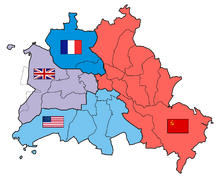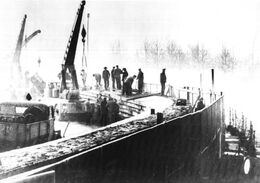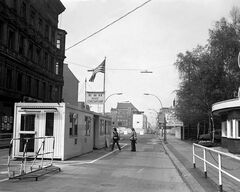
In 1966, Nick secretly travelled to East Berlin to seek a cure for vampirism.
East Berlin was the name given to the eastern part of Berlin between 1949 and 1990. It consisted of the Soviet sector of Berlin (which was established in 1945 after the end of World War II), and was the de facto capital of East Germany.
In the episode, "1966", Nick Thomas—better known to viewers as Nick Knight—travels surreptitiously to East Berlin in search of an ancient book of magic, the Abarat, which is reputed to contain a cure for vampirism. Although a copy of the book is supposed to have been brought to State Archive No. 7, a repository of documents and books, it has never been catalogued. However, there are many boxes whose contents remain unsorted.
Nick manages to obtain the assistance of the night curator, Toffler, and his daughter by offering them the opportunity to escape to the West through catacombs under the Old Bergen Church, near the Berlin Wall. In mid search, the secret police come to the library in search of Nick. Although he succeeds in helping the Tofflers escape, when he returns to look for the Abarat alone, he finds that LaCroix has torched the building in order to prevent Nick from reading the book to find a cure.
The Division of Berlin[]

The four sectors of occupied Berlin, with East Berlin in pink.
In 1945, with the end of World War II, Germany was divided into four zones, each occupied by one of the main Allied Powers: Great Britain, France, the United States, and the Soviet Union. The former capital city of Germany, Berlin, lay wholly within the Soviet zone. However, because of its importance, it was itself divided into four sectors of occupation.
All four of the Allies thus shared responsibility for Berlin. However, the growing political differences between the Western Allies and the Soviet Union led the latter to impose an economic blockade of the three western sectors of Berlin with the intention of forcing the other powers to leave, which would put Berlin wholly under Soviet control. From 24 June 1948 to 11 May 1949, food and other supplies were airlifted into the city in vast quantities in order to break the blockade.
In 1949, American, British and French zones of Germany were united as the Federal Republic of Germany (usually referred to as West Germany). The Soviet zone became the German Democratic Republic (East Germany). Politically, the former looked to the Western powers and the latter to the Soviet Union. The four zones of Berlin were not, strictly speaking, included in the new countries. However, the Soviet sector became the de facto capital of East Germany. West Berlin initially remained a free city, separate from the Federal Republic of Germany: it even issued its own postage stamps.
With the closing of the Inner German border officially in 1952, the border in Berlin remained considerably more accessible than the rest of the border because it was administered by all four occupying powers. Accordingly, Berlin became the main route by which East Germans left for the West. Those actually caught trying to leave East Berlin were subjected to heavy penalties, but with no physical barrier—and even subway train access to West Berlin—such measures were ineffective. By 1961, some 3.5 million East Germans had fled, or approximately 20% of the entire East German population.

The construction of the Berlin Wall in 1961.
Tensions between the two blocs of power culminated in East Germany's construction of barriers around West Berlin on Sunday, 13 August 1961. At midnight, the police and units of the East German army began the operation, and were finished by morning. East German troops and workers then began to tear up streets running alongside the border to make them impassable to most vehicles. They also installed barbed wire entanglements and fences around the three western sectors and along the boundary which actually divided West and East Berlin. Two days later, the first concrete blocks were laid to build the Berlin Wall itself.
Chain fences, walls, minefields, and other obstacles were also eventually installed along the length of the border between East and West Germany.
West Berlin was now de facto a part of West Germany with a unique legal status. However, its precariously isolated position meant that the West German government was located elsewhere, in the new capital of Bonn.

Checkpoint Charlie in 1977.
It was possible for Westerners to pass from one side of Berlin to the other only through strictly controlled checkpoints. There were eight of these, the most famous of which was Checkpoint Charlie, which was restricted to Allied personnel and foreigners. It was the vehicle and pedestrian checkpoint at the corner of Friedrichstraße and Zimmerstraße.
For most Easterners, travel to West Berlin or West Germany was no longer possible.
The creation of the Wall had important implications for both German states. By stemming the exodus of people from East Germany, the East German government was able to reassert its control over the country. However, the Wall proved a public relations disaster for the communist bloc as a whole. Western powers used it in propaganda as a symbol of communist tyranny, particularly when people trying to defect were shot.
The Berlin Wall was more than 140 kilometres (87 mi) long. In June of 1962, a second, parallel fence some 100 metres (110 yd) farther into East German territory was built. The houses contained between the fences were razed and the inhabitants relocated, thus establishing the No Man's Land that later became known as The Death Strip. The No Man's Land was covered with raked gravel that offered no cover, and clear fields of fire for the wall guards. In its final version, the top of the Berlin Wall was lined with a smooth pipe, intended to make it more difficult to scale. It was reinforced by mesh fencing, signal fencing, anti-vehicle trenches, barbed wire, dogs on long lines, "fakir beds" under balconies hanging over the "death strip", over 116 watchtowers, and 20 bunkers.
During the Wall's existence there were around 5,000 successful escapes to West Berlin. It is uncertain how many people died trying to cross the wall; but an ongoing historic research group at the Center for Contemporary Historical Research (ZZF) in Potsdam has confirmed 136 deaths. Successful escape methods included long tunnels, waiting for favorable winds and taking a hot air balloon, sliding along aerial wires, and flying ultralight aircraft.
On 9 November 1989, the Berlin Wall was mostly demolished. On 3 October 1990, the two parts of Germany were reunified as the Federal Republic of Germany; and Berlin once again became the German capital.
- Adapted from the Wikipedia articles on Berlin, East Berlin, and Berlin Wall.